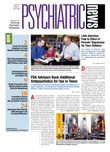Mental disorders are among the strongest predictors of suicide attempts and suicide deaths. But which disorders are the culprits? Depressive disorders, right? Wrong, a new study has found. The answer is anxiety disorders, impulse control disorders, and substance use disorders.
The lead investigator was Matthew Nock, Ph.D., an associate professor of social sciences at Harvard University. The senior investigator was Ronald Kessler, Ph.D., a professor of health care policy at Harvard Medical School. Results were published online March 31 in Molecular Psychiatry.
Between 2001 and 2003, Kessler and colleagues undertook a formidable challenge—determining the status of Americans' mental health. Their assessment, called the National Comorbidity Survey Replication (NCS-R), was based on detailed interviews with more than 9,000 Americans representative of the American population. The first and major results from the survey were published in 2005 (Psychiatric News, July 15, 2005). Now Nock, Kessler, and several other Harvard colleagues have analyzed NCS-R material and determined which mental disorders are the strongest predictors of suicidal behaviors.
The researchers used responses from some 5,700 participants in the NCS-R survey for this particular study. The cohort included all NCS-R participants who had had a DSM-IV Axis I disorder at some point in their lives as well as a subsample of the rest of the NCS-R participants. Each participant had also reported whether he or she had ever had any suicidal ideas or had ever made any suicidal plans or attempts and, if so, when. The researchers then looked to see whether there were any links between having had a particular mental disorder and subsequently contemplating suicide or making a suicidal plan or attempt, while taking other mental disorders into consideration.
A major depression was the strongest predictor of suicidal ideation, they found. Individuals who had had a major depression were more than twice as likely to think about suicide as those who had not. But once these individuals were thinking about suicide, a major depression did not significantly predict whether they would make a suicidal plan or attempt suicide. However, anxiety disorders, impulse control disorders, and substance use disorders did.
For instance, individuals who were thinking about suicide and had had bipolar disorder were over twice as likely to make a planned suicide attempt as individuals without this illness. Those who were thinking about suicide and had posttraumatic stress disorder or a conduct disorder were more than twice as likely to make an unplanned suicide attempt as those who had not had these conditions. And individuals who were contemplating suicide and had had alcohol abuse or dependence were almost three times more likely to make an unplanned suicide attempt as were individuals who were contemplating suicide, but who did not have such a history.
“Results suggest that the onset of suicidal ideation is best predicted by depression, but depression does not predict further progression to suicide attempt,” the researchers concluded. “Instead, disorders characterized by anxiety/agitation (for example, posttraumatic stress disorder) and poor impulse control (for example, bipolar disorder, conduct disorder, substance disorders) emerged as the strongest predictors of which ideators make suicide plans and attempts.... Future research must further delineate the mechanisms through which people come to think about suicide and progress from suicidal thoughts to attempts.”
Other recent studies have produced similar results. A Finnish study found that anxiety combined with conduct disorder predicted suicidal attempts or completion (Psychiatric News, June 5). A study reported in the January Journal of Nervous and Mental Disease found a link between anxiety symptoms and suicidal thoughts or attempts even when depression was considered. That study's cohort included some 2,800 psychiatric inpatients.
The NCS-R was funded by the National Institute of Mental Health, National Institute on Drug Abuse, Substance Abuse and Mental Health Services Administration, Robert Wood Johnson Foundation, and John W. Alden Trust.
An abstract of “Mental Disorders, Comorbidity, and Suicidal Behavior: Results From the National Comorbidity Survey Replication” is posted at<www.nature.com/mp/journal/vaop/ncurrent/abs/mp200929a.html>.▪
